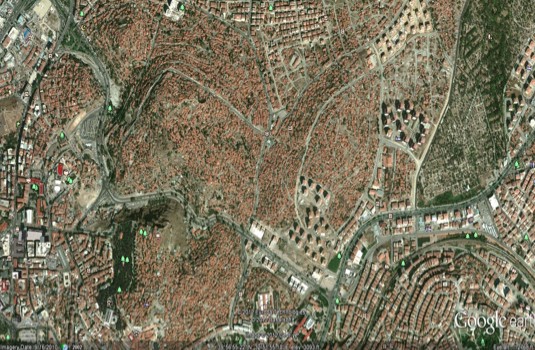
By Matthew Woundy
Ankara is composed of a number of smaller municipalities, the poorest of which is Altindag, home to 407,101 people (TurkStat, 2000). The municipal area is 167 kilometers squared, yielding a population density of 2,438 people per kilometers squared. Altindag also has a large floating population, expanding the daytime population to over a million as people enter to work in Altindag’s large commercial sector. This phenomenon creates additional demands on infrastructure services in the municipality, which already lacks capacity to adequately serve permanent residents (United States Embassy in Ankara, 2004).
85% of housing stock in Altindag is gecekondu, a Turkish term for shanties built by the urban poor (Danis & Albayraktaroglu, 2009). To upgrade substandard housing like gecekondu, urban renewal projects have been implemented. However, of the 30 kilometers squared of gecekondu settlements present in Altindag only 28% are included in urban renewal plans (Koroglu & Ercoskun, 2010). Because the addition formal water and electricity networks to gecekondu settlements is often a precursor to new housing construction (Duyar-Kienast, 2005), Altindag’s population lacks reliable and legal access to the piped water and electricity.
Coping
The people of Altindag deal with water and electricity constraints in two ways. First is the common-in-slums method of illegal connections to existing infrastructure. Ankara gecekondu have semi-operational taps and electricity connections 64% and 88% of the time, respectively, often by utilizing illegal connections (Duyar-Kienast, 2005).
The second coping mechanism when services like electricity and water are absent is making use of local government programs. Altindag utilizes foreign aid to create a conditional cash transfer (CCT) program that pays parents to educate children and visit health care providers (United States Embassy in Ankara, 2004). Altindag also operates a program that supplies 14,000 families with coal for home heating and cooking (ibid.). The municipality’s administrative branch, Altinay, provides services to the population including dispensing food packs and coats to poor households (Danis & Albayraktaroglu, 2009).
Response
Turkish urban improvement programs neglect Altindag, a fact that drives my first recommendation that Turkey decouple the transformation of gecekondu housing settlements with infrastructure investments. Priority should be given to extending reliable water and power lines to all households in Altindag. Urban housing programs should monitor households’ access to reliable and legal infrastructure networks, focusing on access to vital services over phasing out gecekondu settlements.
Second, municipal aid programs such as the allocation of charcoal should be scaled up as a larger arrangement with fiscal transfers from beyond the municipal level. The same is recommended for the CCT program that provides funds for families to purchase vital goods and services like health care, charcoal and water in times of scarcity. It would take only modest transfers from higher levels of government to expand the reach of these programs and generate a much larger impact among poor households in Altindag, an important gesture in the absence of a faster extension of infrastructure into the municipality.
This article is a product of Professor Shagun Mehrotra’s Global Urban Environmental Policy class. Views expressed are entirely those of the individual author
References
Armatli Koroglu, B. & Ercoskun, Y. (2010). Urban Transformation: a Case Study on 7 ?áukurambar, Ankara. Gazi University Journal of Science, 19(3). Retrieved February 6, 2012, from http://www.fbe.gazi.edu.tr/dergi/ojs/index.php/GUJS/article/view/202/130
Danis, M. Z.; Albayraktaroglu, S. 2009. The social dimensions of local governments in turkey: social work and social aid, a qualitative research in Ankara case. Humanity and Social Sciences Journal 4 (1): 90-106. Retrieved February 6, 2012, from http://www.idosi.org/hssj/hssj4(1)09/12.pdf
Duyar-Kienast, Umut. (2005). The formation of gecekondu settlements in Turkey: the case of Ankara. Munster, Germany. LIT Verlag.
Google. (2012). Google Earth (Version 6.0.3.2197) [Software]. Available from http://www.earth.google.com
United States Embassy in Ankara. (2004). A glimpse of urban poverty in turkey. Retrieved February 6, 2012, from http://wikileaks.org/cable/2004/11/04ANKARA6213.html.
Turkish Statistical Institute (Turkstat). (2000). 2000 General Population Census. Retrieved February 6, 2012, from http://www.turkstat.gov.tr/VeriBilgi.do?tb_id=39&ust_id=11